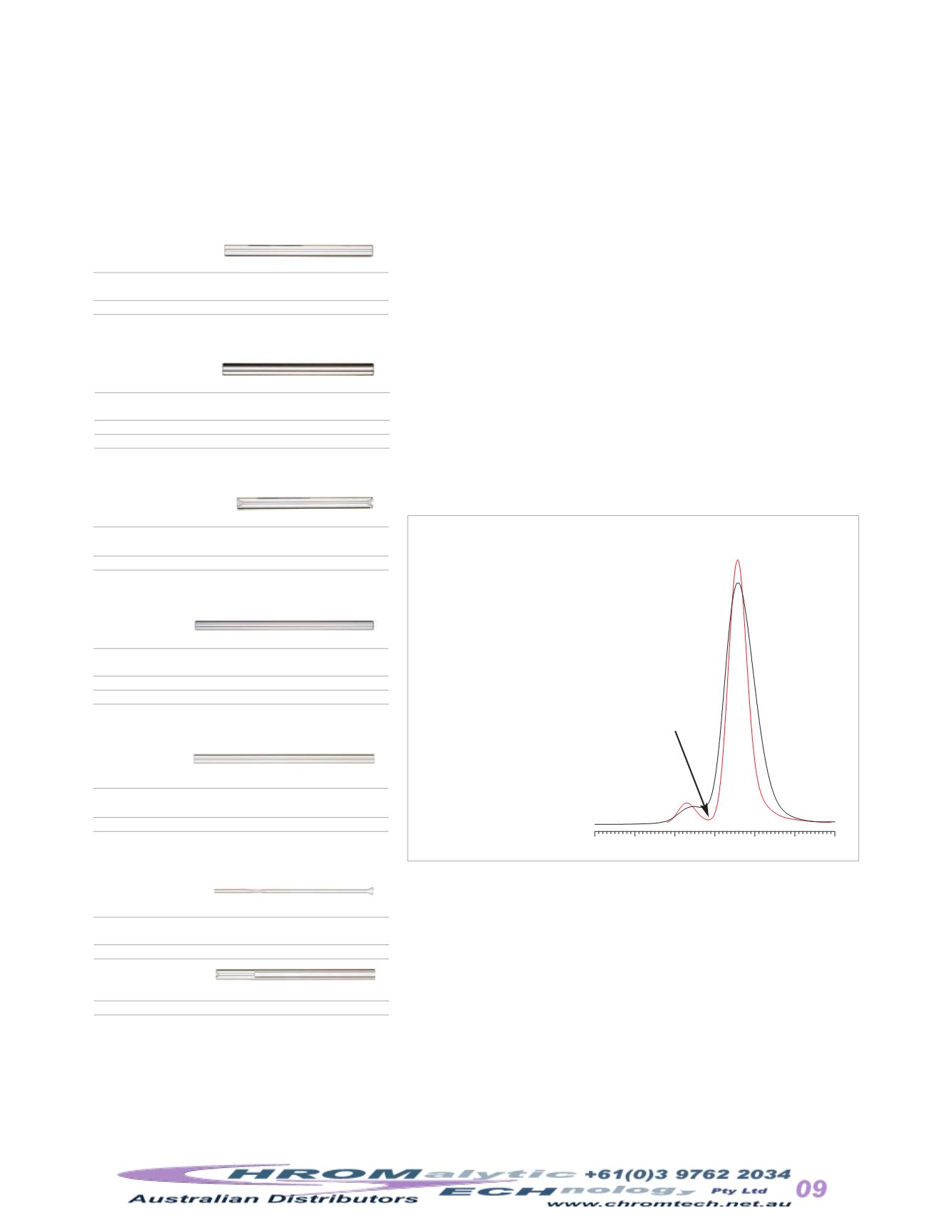
Figure10
Improve system suitabilitypass ratesusing smallerbore liners.
Implementing the revisedmethod forUSP<467> can be difficult if the instru-
ment isnotoptimizedcorrectly.Key issues toaddresswhen settingupheadspace
GC systems includeminimizing systemdead volume,maintaining inert sample
flow paths, and achieving efficient sample transfer. While the second supple-
ment contains a change that allows formodifications to the split ratio, column
and liner choices are critical to analytical success.
UseSmallerBoreLiners forBetterResolution
The functionof an injectionport inheadspace analysis is verydifferent than in
direct liquid injection. In direct injection, the sample is vaporized in the injec-
tionport and larger volume liners (e.g., 4mm) are typically used since the liner
must be able to accommodate the solvent expansion volume. In contrast, in
headspace analysis, the sample is vaporized inside the headspace vial and the
resulting gas sample is simply transferred into the injection port via a transfer
line or syringe injection. Since solvent vaporizationdoes not occur in the liner,
a large volume liner is not needed and, in fact, the use of one can cause delete-
rious effects such as band broadening and decreased peak efficiency. For head-
space applications, a smaller bore liner, preferably 1mm, is recommended. The
smaller liner volume reduces band broadening by increasing linear velocity in
the liner allowing faster sample transfer and improving resolution (Figure 10).
SpeedUpMethodDevelopmentUsingaRetentionTime Index
ICH guidelineQ3C states that residual solvents need only be testedwhen pro-
ductionorpurificationprocessesareknown toresult in thepresenceof such sol-
vents. Therefore, inmany cases exhaustive testing is not needed and individual
validatedmethods for smaller, specific analyte lists are an option. To simplify
column selection and reduce method development time, Restek has created a
retention time index for ICHClass 1,2, and3 residual solventsonvariousphas-
es (Table I). To use this index, simply locate the analytes of interest on the list
anddeterminewhichphase gives the optimal amount of resolution—or differ-
ence in retention time—between your target compounds.A critical coelution is
indicated by a failure to achieve a retention time difference of greater than 1.5
minutes.
OptimizeYourTestingProcedure
Tools, Tips, &Techniques for ImprovingMethodPerformance
•
8
•
Resolution=1.35 for
the1mm liner
1. acetonitrile
2. dichloromethane
GC_PH00912
Resolutionpasses ifusing
a1mm liner (red line),but
failswitha4mm liner
(black line).
4.30
4.40
4.50
4.60
4.70
4.80
Time (min)
1
2
1mmSplitLiners forAgilentGCs
ID* x OD& Length
qty.
cat.#
1mm Split**
1.0mmx 6.3mmx 78.5mm ea.
20972
1.0mmx 6.3mmx 78.5mm 5-pk.
20973
*Nominal ID at syringe needle expulsion point.
**Use this liner for increased sensitivity.
2mmSplitlessLiners forAgilentGCs
ID* x OD& Length
qty.
cat.#
2mm Splitless
2.0mmx 6.5mmx 78.5mm ea.
20712
2.0mmx 6.5mmx 78.5mm 5-pk.
20713
2.0mmx 6.5mmx 78.5mm 25-pk.
20714
SplitLiners forVarian1075/1077GCs
ID* x OD& Length
qty.
cat.#
1mm Split
1.0mmx 6.3mmx 72mm
ea.
20970
1.0mmx 6.3mmx 72mm 5-pk.
20971
SplitLiners forShimadzuGCs
ID* x OD& Length
qty.
cat.#
1mm Split
1.0mmx 5.0mmx 95mm
ea.
20976
1.0mmx 5.0mmx 95mm 5-pk.
20977
1.0mmx 5.0mmx 95mm 25-pk.
20978
SPMELiners forShimadzu17A,2010,
and2014GCs
ID* x OD& Length
qty.
cat.#
SPME Liner
.75mmx 5.0mmx 95mm
ea.
22278
.75mmx 5.0mmx 95mm 5-pk.
22279
ZeroDilutionLiners forPerkinElmerAutoSYS™
andClarusGCs
ID* x OD& Length
qty.
cat.#
ZeroDilution Inner Liner
1.0mmx 2.0mmx 73mm
ea.
22990
1.0mmx 2.0mmx 73mm 5-pk.
22991
ZeroDilutionOuter Liner
2.5mmx 6.2mmx 90mm
ea.
22992
2.5mmx 6.2mmx 90mm 5-pk.
22993
UseSmaller BoreLiners for
Better Efficiency


